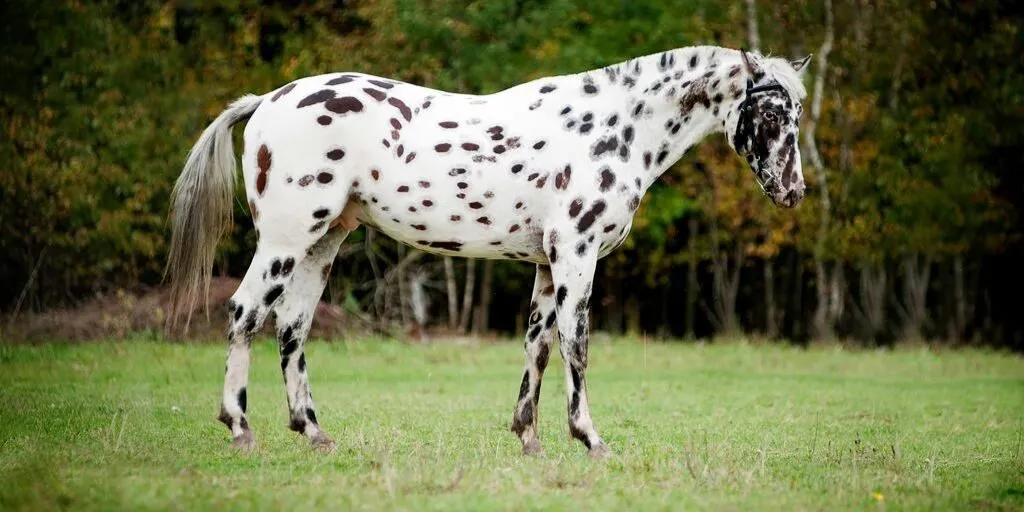The Knabstrupper is a horse breed that originated in Denmark.
They are known for their unique markings and are often used as carriage horses.
While they are not the most common breed of horse, they are worth learning about if you are interested in horses.
This article will tell you everything you need to know about them, from their physical characteristics to their temperament and history.
So, whether you are just curious or thinking of adding a Knabstrupper to your stable, read on!
Knabstrupper Breed Info
Here are some of the key things you need to know about the Knabstrupper:
| Height (size) | 14.2 – 16.0 hands high |
| Colors | Wide variety of coat patterns that range from solid colors with a few leopard spots to full leopard patterns. The full leopard patterns are the most common, and the spots range from black, bay to chestnut. |
| Country of Origin | Denmark |
| Common Uses | Sport Knabstruppers are good at dressage and jumping, Classic type Knabstruppers are popular in circus and driving, and Pony type is great as children’s mount |
Knabstrupper Facts & Information (Breed Profile)
It is thought that the Knabstrupper descended from the ancient spotted horses that were indigenous to what is now Spain.
In these areas, cave paintings of horses with spots were found that resemble the leopard pattern seen in many Knabstruppers.
However, the foundation for the modern Knabstrupper was laid in Denmark in 1812 when a chestnut mare known as Flaebehoppen with intricate leopard patterns was bred to a solid-colored Frederiksborg stallion, which resulted in the birth of a foal with spectacular spotting.
The mare’s name was Flaebehoppen, and her owner, Major Villars Lunn, kept her at a stud called Knabstrupgaard, which is where the breed name comes from.
Offspring of those horses became known as Knabstruppers.
Knabstruppers were utilized as military mounts in the mid-1800s, but their bright coats made them easy targets.
For a few decades, they were Europe’s most sought-after horses, but by the 1870s, the small gene pool had led to inbreeding issues.
Both inbreeding and a fire that claimed the lives of 22 top Knabstruppers in 1891 doomed the unique Danish spotted horse breed.
Nevertheless, a small number of devoted families worked to keep the breed alive.
In 1971, the Knabstruppers received a lifeline in the form of three Appaloosa stallions imported from the United States.
Because of their common Spanish heritage, the Appaloosa was a logical choice for the revival of the Knabstrupper.
Even so, this breed is still rather uncommon, and there are only around 600 individuals left in the world.
The Danish Knabstrupper association was established in 1971, accepting most spotted horses into the registry.
In addition to the Appaloosa, a variety of other breeds were crossed with Knabstruppers in order to generate athletic, brightly colored offspring.
Crosses with Danish Warmbloods, Trakehners, and Holsteiners were the most prevalent, and this helped by strengthening its genetics and boosting its general quality while maintaining the spotted patterning.
Some of the studs were even able to “breed down” to develop pony Knabstruppers suitable for children.
If you’re interested in learning more about this fascinating breed, keep reading!
Alternative Names
“Knabstrup horse”
Temperament/Personality
Friendly, gentle, easy to train
Physical Characteristics
Because they are a “color” breed, Knabstruppers appear in a wide range of sizes and conformations.
What most of them have in common is a balanced large frame.
The head is expressive with small ears.
The neck is well-proportioned, and shoulders are sloped.
The back is strong.
They have great stamina, and are elegant and athletic.
They come in three types: The Sport Knabstrupper with its warmblood influence is taller and leaner.
Classical type (also known as the Baroque type) has a more classical build and movements.
They are also shorter, stronger, and broader than the Sport type, and are used mostly for driving carriages.
Pony Knabstruppers are the children’s favorite because of their captivating colors and amiable personalities.
They stand less than 14.2 hands high.
Further breeding has produced shetland-sized ponies with typical Knabstrupper’s colors.
Colors
Wide variety of coat patterns that range from solid colors with a few leopard spots to full leopard patterns.
The full leopard patterns are the most common, and the spots range from black, bay to chestnut.
Height (size)
14.2 – 16.0 hands high
Stallions
n/a
Mares
n/a
Weight
Up to 1,150 lbs (520 kg)
Blood Type
Warm
Common Uses
Sport Knabstruppers are good at dressage and jumping, Classic type Knabstruppers are popular in circus and driving, and Pony type is great as children’s mount
Health
n/a
Popular Traits
Spotty coat
Feeding/Diet
Easy keepers
Country of Origin
Denmark
Ancestors
A mare called Flaebehoppen, and a Frederiksborg stallion, later Appaloosa
